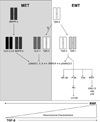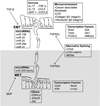The relevance of the TGF-β Paradox to EMT-MET programs
- PMID: 23474494
- PMCID: PMC3752409
- DOI: 10.1016/j.canlet.2013.02.048
The relevance of the TGF-β Paradox to EMT-MET programs
Abstract
The role of transforming growth factor-β (TGF-β) during tumorigenesis is complex and paradoxical, reflecting its ability to function as a tumor suppressor in normal and early-stage cancers, and as a tumor promoter in their late-stage counterparts. The switch in TGF-β function is known as the "TGF-β Paradox," whose manifestations are intimately linked to the initiation of epithelial-mesenchymal transition (EMT) programs in developing and progressing carcinomas. Indeed, as carcinoma cells emerge from EMT programs stimulated by TGF-β, they readily display a variety of acquired phenotypes that provide a selective advantage to growing carcinomas, including (i) enhanced cell migration and invasion; (ii) heightened resistance to cytotoxic agents, targeted chemotherapeutic, and radiation treatments; and (iv) boosted expansion of cancer-initiating and stem-like cell populations that underlie tumor metastasis and disease recurrence. At present, the molecular, cellular, and microenvironmental mechanisms that enable post-EMT and metastatic carcinoma cells to hijack the oncogenic activities of TGF-β remain incompletely understood. Additionally, the molecular mechanisms that counter EMT programs and limit the aggressiveness of late-stage carcinomas, events that transpire via mesenchymal-epithelial transition (MET) reactions, also need to be further elucidated. Here we review recent advances that provide new insights into how TGF-β promotes EMT programs in late-stage carcinoma cells, as well as how these events are balanced by MET programs during the development and metastatic progression of human carcinomas.
Keywords: Epithelial plasticity; Metastasis; TGF-β.
Copyright © 2013 Elsevier Ireland Ltd. All rights reserved.
Conflict of interest statement
Figures


Similar articles
-
Deconstructing the mechanisms and consequences of TGF-β-induced EMT during cancer progression.Cell Tissue Res. 2012 Jan;347(1):85-101. doi: 10.1007/s00441-011-1199-1. Epub 2011 Jun 21. Cell Tissue Res. 2012. PMID: 21691718 Free PMC article. Review.
-
Epithelial-mesenchymal transition is regulated at post-transcriptional levels by transforming growth factor-β signaling during tumor progression.Cancer Sci. 2015 May;106(5):481-8. doi: 10.1111/cas.12630. Epub 2015 Mar 9. Cancer Sci. 2015. PMID: 25664423 Free PMC article. Review.
-
TGF-β signaling and epithelial-mesenchymal transition in cancer progression.Curr Opin Oncol. 2013 Jan;25(1):76-84. doi: 10.1097/CCO.0b013e32835b6371. Curr Opin Oncol. 2013. PMID: 23197193 Review.
-
Lack of transforming growth factor-β signaling promotes collective cancer cell invasion through tumor-stromal crosstalk.Breast Cancer Res. 2012 Jul 2;14(4):R98. doi: 10.1186/bcr3217. Breast Cancer Res. 2012. PMID: 22748014 Free PMC article.
-
The pathophysiology of epithelial-mesenchymal transition induced by transforming growth factor-beta in normal and malignant mammary epithelial cells.J Mammary Gland Biol Neoplasia. 2010 Jun;15(2):169-90. doi: 10.1007/s10911-010-9181-1. Epub 2010 May 15. J Mammary Gland Biol Neoplasia. 2010. PMID: 20467795 Free PMC article. Review.
Cited by
-
MRI detection of breast cancer micrometastases with a fibronectin-targeting contrast agent.Nat Commun. 2015 Aug 12;6:7984. doi: 10.1038/ncomms8984. Nat Commun. 2015. PMID: 26264658 Free PMC article.
-
Epigenetic Regulation of Inflammatory Cytokine-Induced Epithelial-To-Mesenchymal Cell Transition and Cancer Stem Cell Generation.Cells. 2019 Sep 25;8(10):1143. doi: 10.3390/cells8101143. Cells. 2019. PMID: 31557902 Free PMC article. Review.
-
The role of the tumor microenvironment in colorectal cancer and the potential therapeutic approaches.J Clin Lab Anal. 2022 Aug;36(8):e24585. doi: 10.1002/jcla.24585. Epub 2022 Jul 8. J Clin Lab Anal. 2022. PMID: 35808903 Free PMC article. Review.
-
Mysteries of TGF-β Paradox in Benign and Malignant Cells.Front Oncol. 2014 May 13;4:94. doi: 10.3389/fonc.2014.00094. eCollection 2014. Front Oncol. 2014. PMID: 24860782 Free PMC article. Review.
-
Vicious cycle of TGF-β signaling in tumor progression and metastasis.Am J Clin Exp Urol. 2014 Jul 12;2(2):149-55. eCollection 2014. Am J Clin Exp Urol. 2014. PMID: 25374917 Free PMC article. Review.
References
Publication types
MeSH terms
Substances
Grants and funding
LinkOut - more resources
Full Text Sources
Other Literature Sources
Molecular Biology Databases
Miscellaneous

